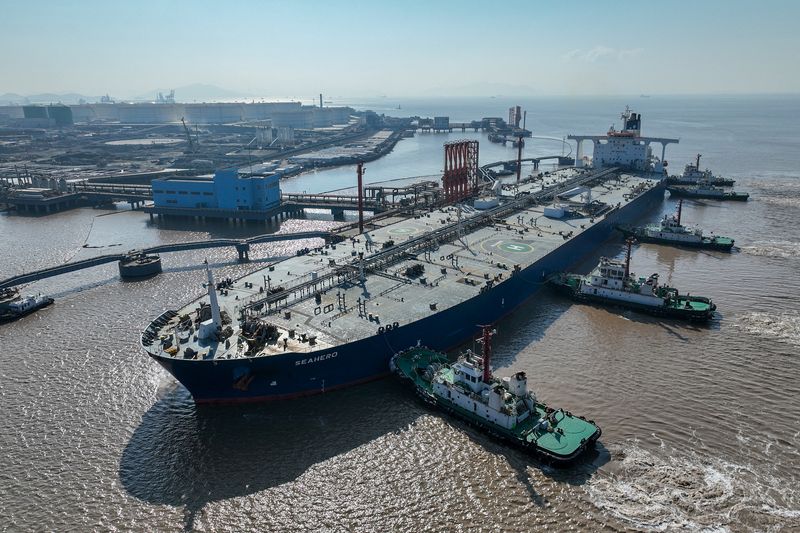[ad_1]

© Reuters. FILE PHOTO: An aerial view shows a crude oil tanker at an oil terminal off Waidiao island in Zhoushan, Zhejiang province, China January 4, 2023. China Daily via REUTERS/File Photo
By Shariq Khan
BENGALURU (Reuters) -Oil prices rose about a dollar a barrel on Friday on signs of slowing U.S. output, but both crude benchmarks looked set to end their longest rally of 2023 on mounting concerns about global demand growth.
U.S. West Texas Intermediate (WTI) crude futures were up $1.08, or 1.3%, to $81.47 a barrel at 1:09 p.m. EDT [1708 GMT], while the global benchmark rose 81 cents, or 1%, to $84.93 a barrel.
Both benchmarks pushed higher on Friday after industry data showed that the U.S. oil and rig count, an early indicator of future output, fell for a sixth week in a row. A slump in U.S. production could exacerbate an anticipated supply tightness through the rest of this year.
Those concerns, spurred on by output cuts from the Organization of the Petroleum Exporting Countries and allies, helped oil prices gain for seven straight weeks since June. Brent crude gained about 18% and WTI gained 20% over the seven weeks ended Aug. 11.
This week, however, oil prices are set to fall 2% as a worsening property crisis in China has added to concerns about the country’s sluggish economic recovery and reduced investors appetite for risk across markets.
“Concerns for investors remain focused on the tension between slowing global growth and still-tight global supplies,” said Rob Haworth, senior portfolio manager at U.S. Bank Asset Management.
“Prices are likely to remain range-bound for now,” Haworth said, adding that demand is in question for investors worried by the weak data from China.
Concern is also mounting that the U.S. Federal Reserve has not finished raising interest rates to tackle inflation. Higher borrowing costs can impede economic growth and in turn reduce overall demand for oil.
Oil benchmarks were further depressed by seasonal demand weakness heading into the autumn, said Jay Hatfield, CEO of Infrastructure Capital Management.
Hatfield said he expects demand to hold up in China despite its slowing economy and forecast oil prices would trade between $75 to $90 a barrel over the coming months.
[ad_2]
Source link
(This article is generated through the syndicated feed sources, Financetin doesn’t own any part of this article)
